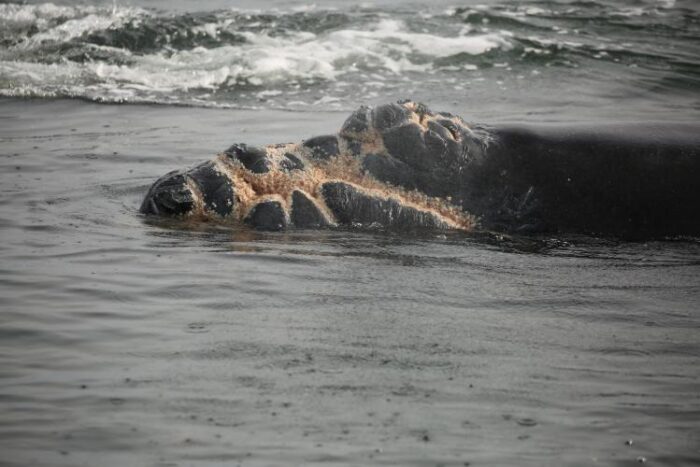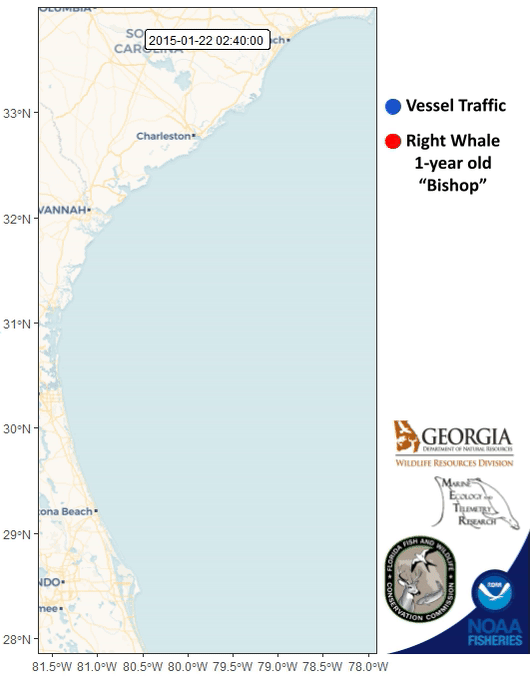There is still hope for one of earth’s most endangered whales
With only 360 critically endangered North Atlantic right whales left, each birth is vital to their survival.
Every year around November, North Atlantic right whales embark on a treacherous journey from their feeding grounds in the Northeast to their calving grounds off the Southeastern coast. Along the way, the whales must navigate through a labyrinth of boats and fishing gear across our Eastern seaboard.
But making it to their destination couldn’t be more necessary: Through April, the waters off the Carolinas, Georgia, and Florida are the only place on the planet where the whales are known to give birth and raise their young.
These iconic whales drive tourism in coastal communities along the Southeast coast and, like all large whales, play an important role in the ecosystem and mitigating the impacts of climate change. This calving season so far, 17 new calves have been spotted. With excitement of the births comes hope of the future for the species.
A “state of emergency” for the species
Yet spotting them is getting tougher as the species experiences an “unusual mortality event,” a state of emergency declared by the National Oceanic and Atmospheric Administration (NOAA) in 2017 after human activities killed 19 whales in one year. High annual rates of mortality have persisted, and the designation remains in effect today – this calving season, three calves have been killed or lost, demonstrating the urgent need for action.

NOAA closely monitors calving season off our Southeastern coast due to the importance of new calves to the population’s survival – and births must outpace total deaths in the population for the species to survive, a big challenge with only 70 reproductive females left.
“News of multiple right whales killed by human activities this year has marred what should be a joyful calving season,” says Sierra Weaver, Leader of SELC’s Coast and Wetlands Program. “This critically endangered species simply cannot calve their way out of extinction – they need our help now.”
Two main threats to right whales’ survival
Human caused deaths currently exceed the birth rate of new calves. This is due to the two biggest threats to right whales’ survival – boat strikes and entanglements with commercial fishing gear. And with climate change altering ocean ecosystems, whales have turned up in new places at unexpected times, making it more difficult for them to feed and more difficult for existing measures to protect them. While NOAA keeps track of right whale sightings and deaths, as many as two-thirds of right whales die without being detected.
Realizing that most people will never encounter a right whale, whether alive or deceased, in their lifetime is a humbling and sobering thought.
Lauren Rust, Lowcountry Marine Mammal Network
With the estimated rate of births needed to survive so high, reducing human-caused mortality is the only solution – right whales need enhanced protections to survive these present threats.
Right whale deaths in Southern waters
Juno, the first documented right whale mother of the current calving season, was spotted with a new calf off Georgetown, South Carolina in November. But in January, both whales were seen off Edisto, South Carolina, with Juno’s calf showing likely fatal vessel strike injuries. As experts predicted, Juno’s calf was unable to recover from her injuries and was found dead in March on Cumberland Island, Georgia.

In February, two more right whales were found dead at just one year old. A calf of a right whale named Pilgrim was found dead on Tybee Island in Georgia due to a vessel strike, and a calf of Squilla was found dead at Martha’s Vineyard due to chronic entanglement with fishing gear. Making these losses even more devastating was the fact that these young whales had the potential to later breed and give birth to future right whales – with a mere 70 reproductive females remaining, reproducing only every seven to 10 years, each female is precious.
Lauren Rust is the founder and executive director of the Lowcountry Marine Mammal Network, a nonprofit group dedicated to protecting marine mammals in South Carolina waters. Her work sometimes includes using her expertise to perform necropsies – a post-mortem examination of an animal – on dead right whales, which she describes as “both awe-inspiring and heart-wrenching.”
Says Rust, “It’s a reminder of the beauty and fragility of these creatures, and the urgent need to protect them from extinction. Realizing that most people will never encounter a right whale, whether alive or deceased, in their lifetime is a humbling and sobering thought. Every necropsy carries a profound responsibility to learn from their deaths in order to save other individuals.”
Scientists predict the species will become extinct in our lifetime if human caused deaths are not addressed. Studies show reducing vessel speeds to 10 knots (or about 10 nautical miles per hour) could reduce the risk of death up to 90%. In fact, there are currently no technological alternatives that are proven as effective as vessel speed limits.
Studies show reducing vessel speeds to 10 knots could reduce the risk of death up to 90%.
“Intervention is necessary to give North Atlantic right whales a chance to withstand further losses and reverse their declining numbers,” says Ramona McGee, Leader of SELC’s Wildlife Program. “Existing, proven science can provide the solution.”
Despite news of multiple dead right whales, there are still 17 births to celebrate this calving season. We hope that next year, right whales and calves will be coming to our Southeastern coasts with new, critical protections.
